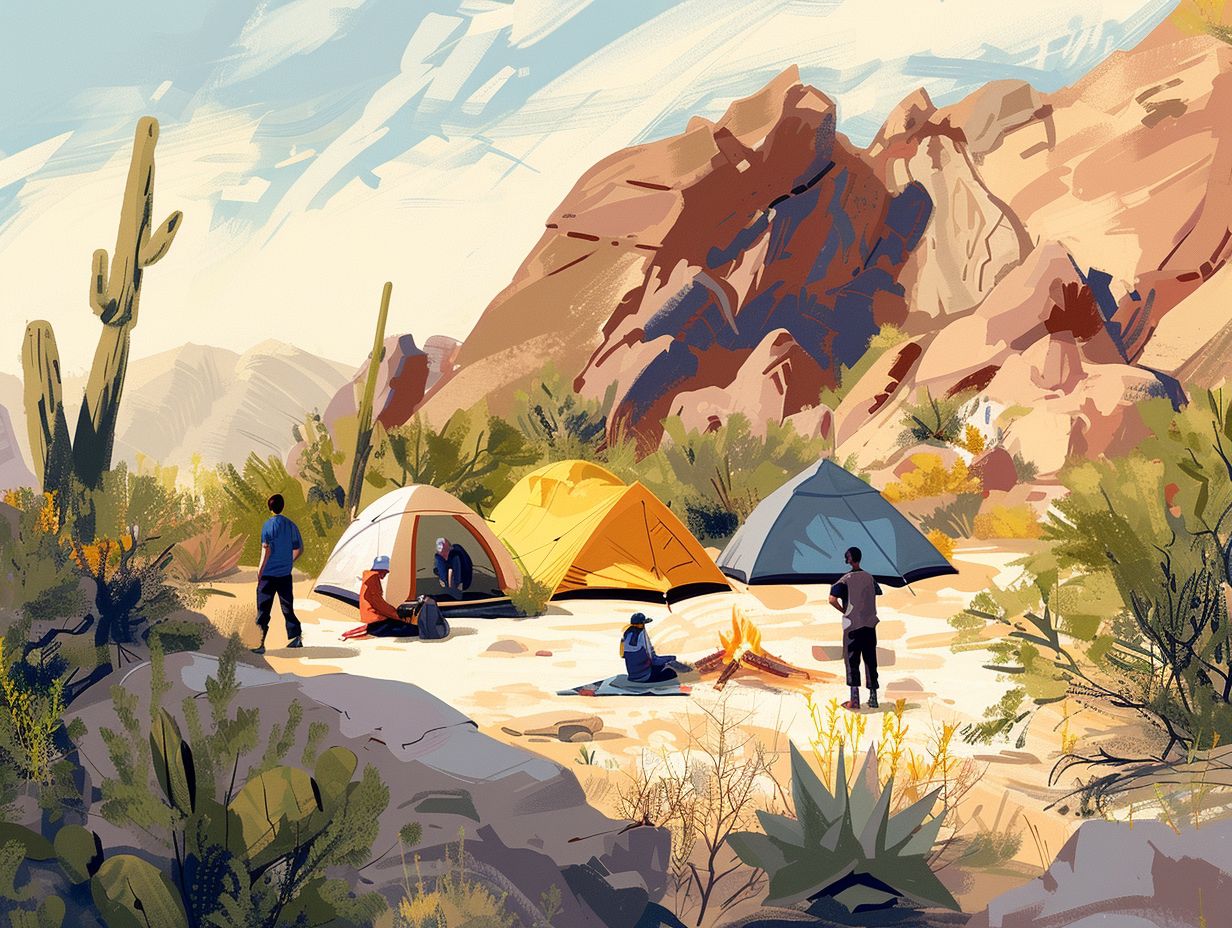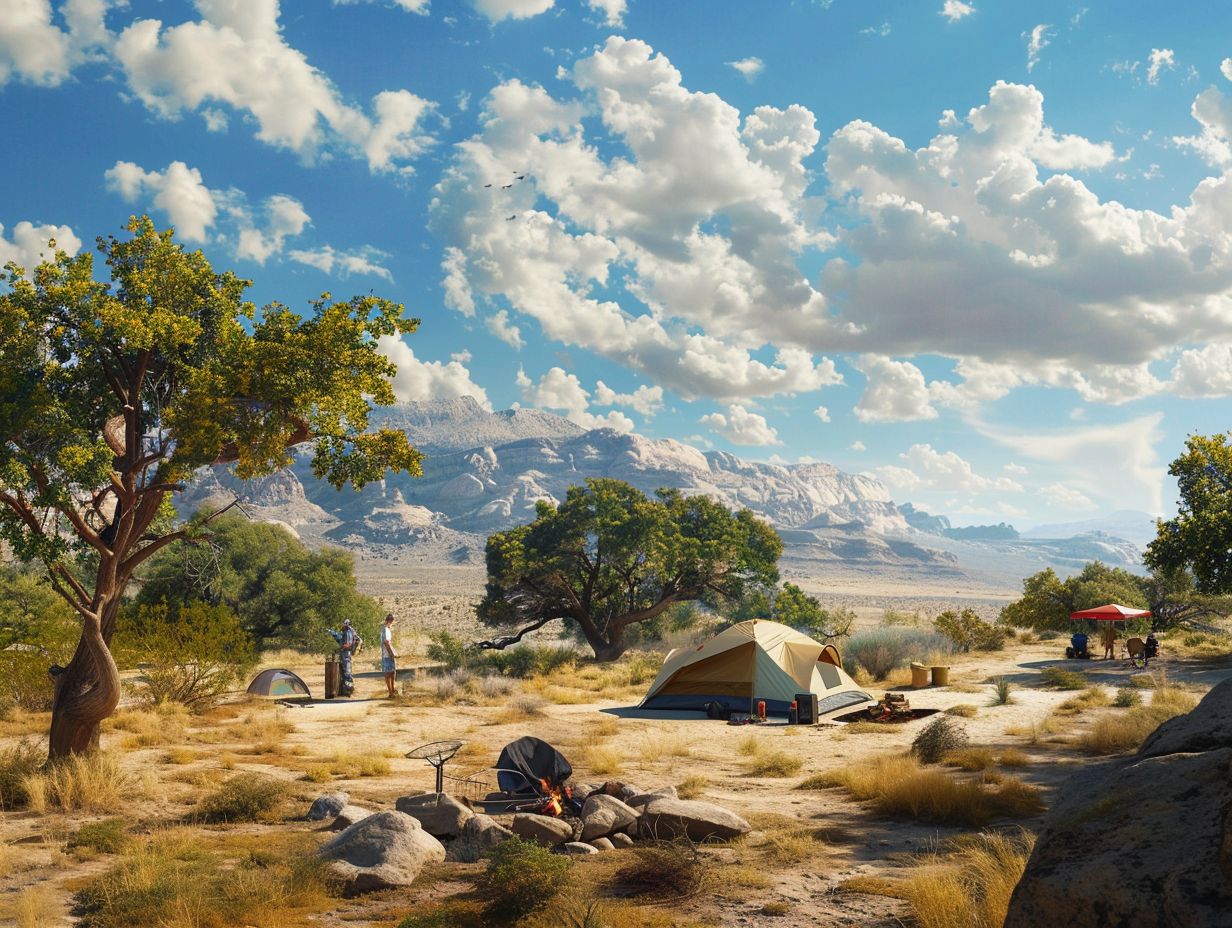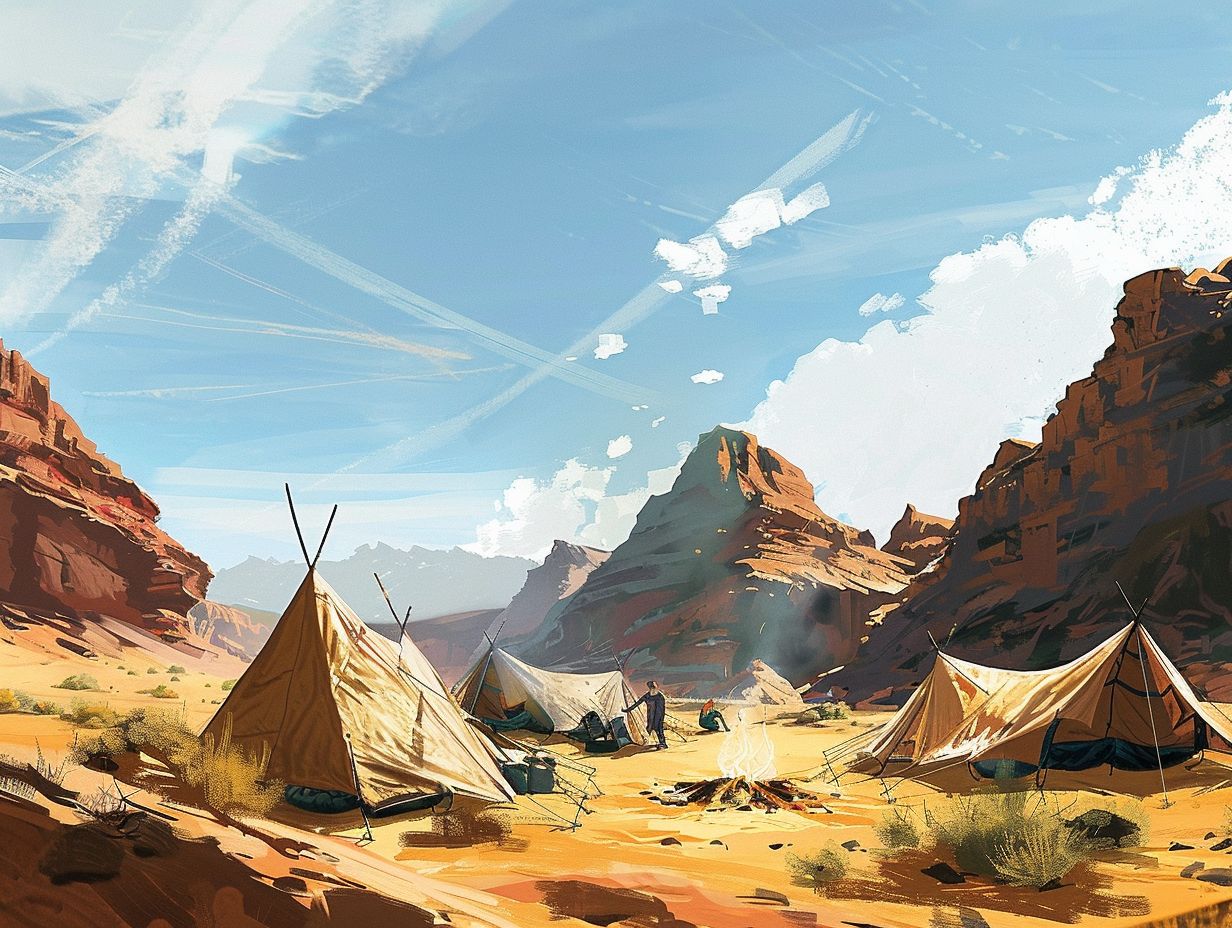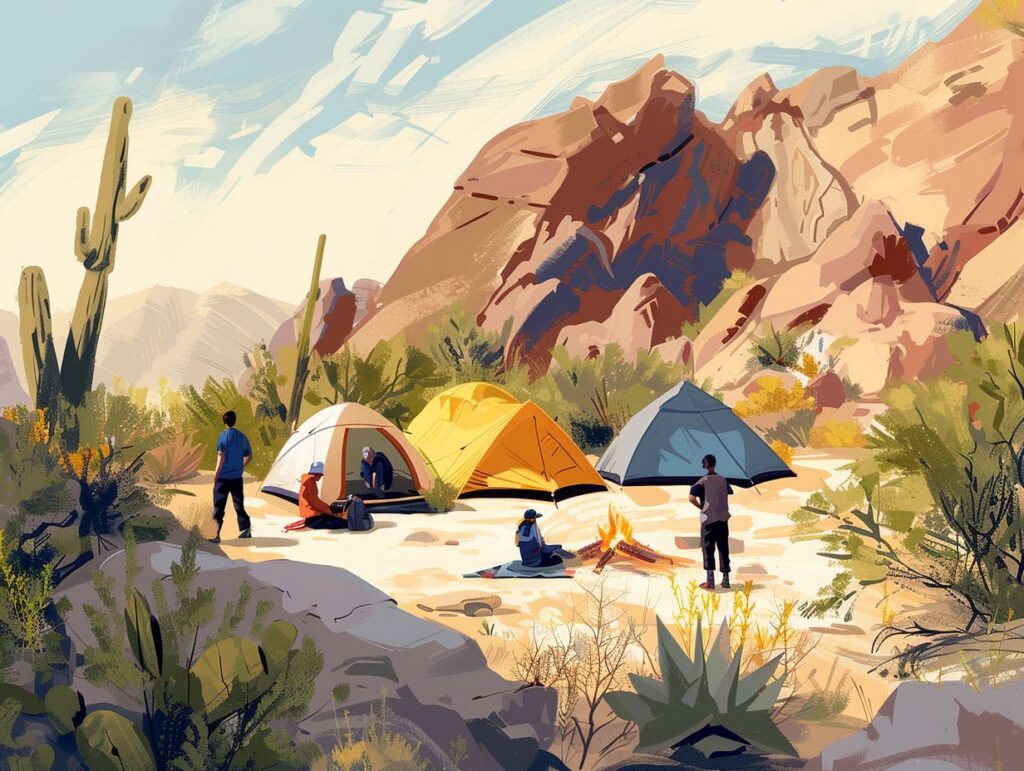Camping in hot weather can be a fun and rewarding experience, but it also comes with its challenges. From dehydration and sunburns to heat exhaustion, it’s important to be prepared when venturing into the great outdoors during the summer months.
In this article, we will discuss the essential items you need for camping in hot weather, as well as some tips for staying cool and safe. Whether you’re a seasoned camper or new to the game, these tips will help ensure a successful and enjoyable camping trip in the heat.
Key Takeaways:

- Stay hydrated by bringing plenty of water and taking breaks in the shade.
- Protect your skin and eyes from sun exposure by wearing sunscreen, hats, and sunglasses.
- Be aware of heat-related illnesses and plan activities for cooler times of the day while camping in hot weather.
Why Is Camping in Hot Weather Challenging?
Camping in warm climates can pose several challenges, largely attributable to the high temperatures and prolonged exposure to solar radiation. Thus, it is imperative to make thorough preparations in order to fully appreciate your outdoor camping experience.
1. Dehydration
Dehydration poses a significant concern when engaging in camping activities during hot weather, as the combination of elevated temperatures and physical exertion accelerates the body’s loss of fluids.
This fluid deficit can manifest through symptoms such as giddiness, tiredness, dry oral cavity, and reduced urinary output. In severe cases, dehydration can lead to adverse outcomes like fainting, mental disorientation, and potential organ impairment, posing substantial health risks.
To mitigate the risk of dehydration while camping, it is imperative to ensure an adequate supply of water and adhere to a consistent intake schedule throughout the day.
Additionally, integrating electrolyte-enhanced beverages such as sports drinks or coconut water into one’s hydration regimen can facilitate the replenishment of vital minerals depleted through perspiration and sustain optimal fluid balance, particularly during prolonged outdoor pursuits.
2. Sunburns
Sunburns can pose a significant risk during camping trips as a result of extended exposure to UV rays, which have the potential to cause skin damage and result in painful burns. To mitigate the risk of sunburn during outdoor activities like camping, it is essential to implement preventative measures.
These measures include the application of sunscreen with a high Sun Protection Factor (SPF) before sun exposure, the use of protective clothing such as hats and sunglasses, and seeking shelter in shaded areas during peak sunlight hours.
It is essential to remember to reapply sunscreen every two hours, especially after swimming or participating in activities that cause sweating, in order to maintain continuous protection against harmful UV rays. By following these simple steps, individuals can reduce the chances of experiencing sunburn and protect their skin from potential harm.
3. Heat Exhaustion
Heat exhaustion is a severe condition that can arise from prolonged exposure to elevated temperatures during outdoor activities such as camping, manifesting symptoms such as dizziness, headache, and fatigue. It is imperative to recognise the indications of heat exhaustion when engaging in outdoor pursuits in warm climates.
Additional common symptoms may include excessive sweating, muscle cramps, and an accelerated heart rate. To mitigate the risk of heat exhaustion, individuals should prioritise adequate hydration by consuming sufficient water throughout the day.
Furthermore, taking regular breaks in shaded areas to lower body temperature and provide periods of rest is essential. Opting for lightweight, loose-fitting attire can facilitate effective temperature regulation by the body in hot environmental conditions.
What Are the Essential Items for Camping in Hot Weather?
When camping in hot weather, possessing the appropriate essential items can significantly enhance one’s comfort and safety, ensuring a pleasant and secure experience in the midst of the intense sun.
1. Sunscreen
The application of suncream is essential to protect the skin from the harmful effects of UV rays, particularly during outdoor activities such as camping in hot weather.
Various types of suncream formulations are available in the market, including mineral-based, chemical-based, and combination sunscreens. Mineral sunscreens typically incorporate active ingredients like zinc oxide and titanium dioxide, which establish a physical barrier on the skin to reflect UV rays. Conversely, chemical sunscreens function by absorbing UV rays and transforming them into heat.
Proper application of suncream involves the use of a liberal amount, ensuring all exposed skin areas are adequately covered. It is important to reapply suncream every two hours, particularly after engaging in activities like swimming or sweating, to maintain continuous protection throughout the day.
2. Hats and Sunglasses

The use of hats and sunglasses is essential to protect one’s face and eyes from the strong sunlight during camping trips.
Wide-brimmed hats are particularly useful as they provide significant shade not just for the face but also for the neck and shoulders, offering protection against harmful ultraviolet (UV) rays. In addition, polarised sunglasses are highly recommended to reduce glare and enhance visual clarity, especially important during outdoor activities such as walking or fishing.
By using these accessories together, people can improve their camping experience by ensuring comfort and safeguarding themselves from the harmful effects of the sun.
3. Lightweight and Breathable Clothing
It is crucial to prioritise lightweight and breathable clothing when embarking on a hot weather camping trip to ensure optimal comfort and coolness.
Fabrics such as cotton, linen, and bamboo are highly recommended for hot weather conditions because of their natural breathability and moisture-wicking properties. It is advisable to select loose-fitting attire to facilitate air circulation and prevent the risk of overheating.
When layering clothing in hot weather, it is wise to consider lightweight cardigans or shawls crafted from breathable materials like chiffon or silk. These options provide additional coverage without compromising on ventilation.
Conversely, synthetic fabrics like polyester or nylon should be avoided as they have a tendency to trap heat and moisture, potentially causing discomfort and a sticky sensation.
4. Plenty of Water
It is imperative to prioritise adequate hydration when engaging in camping activities in hot weather to mitigate the risk of dehydration. Hydration packs serve as a practical solution for maintaining hydration levels while on the move during camping excursions.
Procuring a high-quality hydration pack enables individuals to transport a significant volume of water conveniently, complete with a hose for effortless consumption while trekking or participating in outdoor pursuits.
Additionally, prudent preparation includes pre-emptively storing extra water in dependable receptacles at the campsite. Consistent water intake throughout the day is pivotal for sustaining energy levels and promoting overall health and vitality during outdoor expeditions.
5. Portable Shade
Portable shade options, such as reflective sunshades and pop-up canopies, serve as essential solutions for mitigating sun exposure while engaged in camping activities. Reflective sunshades, distinguished by their silver coating, effectively redirect sunlight, thereby reducing heat accumulation underneath.
Conversely, pop-up canopies facilitate swift and effortless assembly, creating an expansive shaded area conducive to accommodating group gatherings.
When installing portable shade at a campsite, it is imperative to ensure secure anchoring to withstand potential wind gusts. Optimal positioning of the shade entails maximising coverage during peak sun hours by aligning it towards the sun.
The integration of supplementary accessories like side walls or mesh screens can further fortify protection and privacy, thereby enriching the overall camping experience.
What Are Some Tips for Staying Cool While Camping in Hot Weather?
Maintaining comfort during camping in hot weather requires the implementation of a series of strategies and techniques aimed at effectively managing high temperatures.
1. Choose a Campsite with Shade
Choosing a campsite that offers ample shade is a highly efficient method to maintain coolness during camping in hot weather. Natural shade provided by trees not only offers respite from the intense heat of the sun but also enhances the overall camping experience.
When searching for a shaded campsite, it is advisable to look for locations with dense tree coverage or proximity to a forest where tall trees can create a cooling canopy. Additionally, the use of a canopy or the addition of a portable shade structure can provide additional protection against the sun’s intense rays, especially during midday.
The availability of multiple shade options ensures that campers can enjoy the outdoors comfortably, even in the highest temperatures.
2. Stay Hydrated
Maintaining adequate hydration levels is paramount for supporting the body’s thermoregulatory processes and overall well-being, particularly when embarking on a camping trip in hot weather conditions. Adequate hydration plays a fundamental role in regulating body temperature, mitigating the risk of dehydration, and facilitating proper organ functionality.
To ensure optimal hydration, it is advisable to implement strategies such as setting reminders on electronic devices or utilising a portable hydration pack for convenience. By conscientiously consuming water at regular intervals, individuals can expect heightened levels of energy, enhanced cognitive focus, and a reduced likelihood of health complications stemming from dehydration.
Whether venturing into the great outdoors or engaging in routine daily activities, it is imperative to prioritize hydration as a cornerstone of achieving optimal health and vitality.
3. Take Breaks in the Shade

Engaging in regular shaded breaks can aid in the prevention of heat exhaustion and help maintain a cool body temperature during camping in hot weather. Resting in a cool, shaded area during these intervals is especially advantageous as it enables the body to lower its temperature and recuperate from the heat.
By selecting a shaded location with proper airflow, individuals afford their bodies the opportunity to regulate their temperature and mitigate the risk of overheating. Additionally, this practice can assist in minimising the likelihood of dehydration and sunburn.
Incorporating these breaks as a habitual aspect of one’s camping itinerary can significantly enhance overall comfort and well-being in hot environmental conditions.
4. Use Cooling Towels or Misting Fans
Utilising cooling towels or misting fans can offer immediate relief from high temperatures and assist in maintaining a comfortable environment during camping excursions.
These handy accessories are user-friendly and have the potential to significantly enhance your overall camping experience.
To maximise the effectiveness of a cooling towel, the recommended method is to saturate it with water, gently wring out any excess water, and then position it around your neck or head. The evaporative cooling mechanism of the towel facilitates an immediate reduction in body temperature.
Conversely, misting fans operate by emitting a fine mist of water in conjunction with airflow to produce a cooling effect. By incorporating these items into your camping equipment, you can effectively combat the summer heat and relish outdoor activities in a relaxed and cool atmosphere.
5. Plan Activities for Cooler Times of the Day
Scheduling activities during the early morning or late evening, when temperatures are lower, can enhance comfort and mitigate exposure to the peak heat experienced during midday hours.
Engaging in outdoor pursuits, such as hiking in natural settings, picnicking at local parks, or participating in sunrise or sunset yoga sessions during these cooler intervals, can provide a rejuvenating experience.
To optimise these periods, individuals may consider early rising or adjusting evening commitments to accommodate these enjoyable activities. By proactively planning and emphasizing these cooler time slots, individuals can elevate the enjoyment and invigoration derived from their outdoor endeavors.
How to Stay Safe While Camping in Hot Weather?
Ensuring safety during camping in hot weather requires awareness of potential hazards and the implementation of precautionary measures to reduce the risks of heat-related illnesses and other dangers.
1. Know the Signs of Heat-Related Illnesses
Recognising the indicators of heat-related illnesses, such as heat exhaustion and heatstroke, is imperative for maintaining safety during a camping trip in hot weather.
Heat exhaustion can materialise as profuse sweating, rapid heartbeat, nausea, lightheadedness, and fatigue. Conversely, heatstroke might be characterised by a severe headache, absence of sweating, disorientation, and potential loss of consciousness.
When these symptoms are observed in oneself or others, prompt action is essential. It is advised to relocate to a shaded area, consume water, and loosen any constrictive clothing. In cases of severity, immediate medical attention should be sought. It is important to note that early identification and timely intervention play a critical role in averting serious complications arising from heat-related illnesses.
2. Have a First Aid Kit
Ensuring the availability of a well-equipped first aid kit is essential for addressing any medical concerns that may arise during camping in hot weather.
When setting out on camping trips in hot weather conditions, it is advisable to include essential items in your first aid kit such as adhesive plasters for minor cuts and grazes, antiseptic wipes for wound cleaning, tweezers for removing splinters, and after-sun lotion for protection against sun exposure.
In addition, it is vital to maintain proper hydration levels and apply sun cream regularly to reduce the risk of heat-related illnesses. It is important to have sufficient knowledge on the correct use of these items, for instance, using antiseptic wipes before dressing a wound.
In cases where individuals show severe symptoms such as heatstroke or severe allergic reactions, it is crucial to promptly seek professional medical help.
3. Be Aware of Fire Hazards
The awareness of fire hazards becomes particularly crucial when camping in hot weather, as dry conditions heighten the risk of wildfires. To prevent fires whilst camping, strict adherence to campfire regulations established by the campsite or local authorities is essential.
This entails utilising designated fire pits, maintaining a safe distance from flammable materials, and considering wind conditions.
It is imperative to have a readily available source of water to promptly extinguish any flames that may become uncontrollable. Leaving a fire unattended, even momentarily, poses significant risks as a mere spark can trigger the ignition of nearby vegetation.
By implementing these safety measures, campers can responsibly savour their outdoor experience while mitigating the likelihood of accidental fires.
4. Check Weather Forecasts

It is advisable to consult weather forecasts before and during a camping excursion to maintain preparedness and mitigate the risk of encountering unforeseen heatwaves or storms. It is imperative to rely on credible weather sources, such as official meteorological services or reputable weather websites, to ensure the accuracy and timeliness of weather information.
When organising outdoor activities, it is prudent to modify the itinerary based on the anticipated weather conditions. Implementing contingency plans, such as carrying additional clothing layers for abrupt temperature fluctuations or assembling a robust shelter in anticipation of heavy rainfall, can significantly enhance the overall experience and outcome of the camping trip.
It is important to underscore the importance of adaptability and flexibility in response to fluctuating weather patterns as fundamental elements for a successful outdoor adventure.
Frequently Asked Questions
What should I wear while camping in hot weather?
It is important to wear lightweight, breathable and loose clothing to keep cool while camping in hot weather. Avoid dark colours and opt for light colours to reflect the sun’s rays.
How can I stay hydrated while camping in hot weather?
Make sure to drink plenty of water throughout the day and bring extra water bottles to have on hand. Avoid sugary or caffeinated beverages, as they can dehydrate you faster.
What type of shelter should I use for camping in hot weather?
When camping in hot weather, it is best to use a tent or shelter that is well-ventilated and provides shade. Avoid using dark or thick tents which can trap heat and make the interior feel like a sauna.
What is the best time of day to do outdoor activities while camping in hot weather?
The best time to do outdoor activities in hot weather is during the early morning or late afternoon when the sun is not as strong. This will help you avoid the peak hours of intense heat.
How can I protect myself from the sun while camping in hot weather?
Be sure to always wear sunscreen with a high SPF and reapply regularly. Wear a hat and use a sun umbrella or seek shade during the hottest parts of the day.
What type of food should I bring for camping in hot weather?
Choose lightweight and non-perishable foods that require little to no cooking, such as granola bars, fruit, and nuts. Avoid bringing heavy meals that require a lot of preparation and cooking, as it can cause you to overheat.

